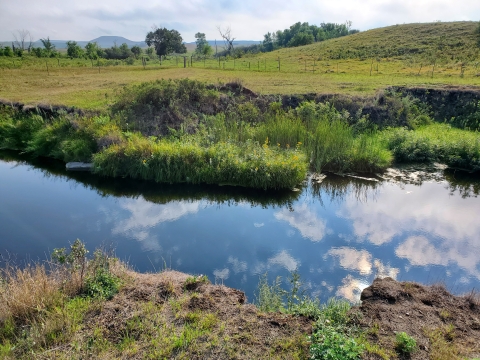What We Do
Wildlife conservation is at the heart of the National Wildlife Refuge System. It drives everything on U.S. Fish and Wildlife Service lands and waters managed within the Refuge System, from the purposes for which a national wildlife refuge national wildlife refuge
A national wildlife refuge is typically a contiguous area of land and water managed by the U.S. Fish and Wildlife Service for the conservation and, where appropriate, restoration of fish, wildlife and plant resources and their habitats for the benefit of present and future generations of Americans.
Learn more about national wildlife refuge is established to the recreational activities offered to the resource management tools used. Using conservation best practices, the Refuge System manages Service lands and waters to help ensure the survival of native wildlife species.
In the Long Lake Wetland Management District, the focus is primarily administration involving the enhancement of private lands for wildlife through cooperative agreements with private landowners. This includes wetland and grassland easements on private lands. An easement is a legal agreement signed with the United States of America, through the U.S. Fish and Wildlife Service, that pays landowners to permanently protect wetlands and/or grasslands. Wetlands covered by an easement cannot be drained, filled, leveled, or burned. When these wetlands dry up naturally, they can be farmed, grazed, or hayed. The grassland easement, frequently used in combination with a wetland easement, restricts haying, mowing, and grass seed harvest until after July 15 of each year. This restriction is to help grassland nesting species, such as ducks and pheasants, complete their nesting before the grass is disturbed.
Management and Conservation
Wildlife managers use a variety of tools to manage habitat for many species of wildlife.
Prescribed Burning
Controlled burns are often called prescribed burns because wildlife managers write a careful prescription of the weather conditions, equipment, and people necessary to safely conduct a burn that will have the desired ecological effect. Fire is used to help wildlife and wildlife habitat by stimulating prairie plant growth, increasing soil nutrients, and setting back the invading trees and other species not adapted to life on the prairie.
Prairie animals are also adapted to fire. Some go underground during the fire. Others simply fly or run away from the fire. Sometimes, birds lose their nests to fire, but native grassland species have an adaptation for this - they quickly respond by building a new nest and laying a new clutch of eggs. While there is some short-term loss to some nests or animals, these same species depend on fire for their survival, since many prairie plants and animals cannot survive long, once shrubs or trees take over their grassland habitat.
Rotational Livestock Grazing
Refuge managers work together with local ranchers to mimic natural disturbances that were once caused by large herds of free-ranging bison and elk on the prairie. Through livestock grazing, invasive cool-season grasses and other invasive plants can be stressed, which favors native grasses and forbs such as western wheatgrass, green needlegrass, blue grama, little bluestem, purple coneflowers, goldenrods, and low growing shrubs. Grazing can greatly influence the structure and diversity of grassland communities.
Water Level Management
To foster desired plant growth, water levels on wetlands are carefully monitored and controlled with water control structures. Management objectives focus on providing habitat and food for nesting, rearing, and migrating birds. An especially important plant, sago pondweed, provides shoots and tubers as a food source for birds. The invertebrates these plants support are also an important food source for waterfowl, shorebirds, and many other wildlife species, especially when nurturing broods.
Invasive Species Control
Invasive species are plants and animals that are not native to an area, and can cause economic or environmental harm. One of the largest threats to public lands in the United States, next to habitat loss, is the invasion of invasive plant and animal species. If left unchecked, invasive species invasive species
An invasive species is any plant or animal that has spread or been introduced into a new area where they are, or could, cause harm to the environment, economy, or human, animal, or plant health. Their unwelcome presence can destroy ecosystems and cost millions of dollars.
Learn more about invasive species can alter habitat and water quality.
Refuge managers use livestock grazing, burning, chemical application and insects to control invasive plants such as smooth bromegrass, Kentucky bluegrass, Canada thistle, absinth wormwood, leafy spurge, Russian olive, and Siberian elm trees.
Our Services
We offer the following services:
- A staffed office at Long Lake National Wildlife Refuge, near Moffit ND, with local hunting and wildlife viewing information.
- Educational brochures, including a map of the Waterfowl Production Areas.
- Environmental education programs for local schools and groups (contact Refuge manager).
- Administration of cooperative agriculture programs.
- Issuance of Special Use Permits.
- Project reviews related to energy development when U.S. Fish and Wildlife Service interests are involved.
- A Partners for Fish and Wildlife program for private landowners who are interested in conservation and funding opportunities on private land.
Laws and Regulations
The National Wildlife Refuge System, the only system of Federal lands devoted specifically to wildlife, is a network of diverse and strategically located habitats. More than 565 national wildlife refuges and thousands of waterfowl production areas across the United States teem with millions of migratory birds. They serve as havens for hundreds of endangered species and host an enormous variety of other plants and animals. Over 39 million people visit units of the National Wildlife Refuge System each year to enjoy a wide range of wildlife related recreational opportunities. To maintain this system, the passage and creation of laws and regulations, such as the National Wildlife Refuge System Improvement Act, ensures a strong and singular wildlife conservation mission.

